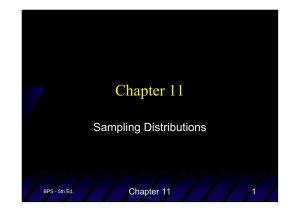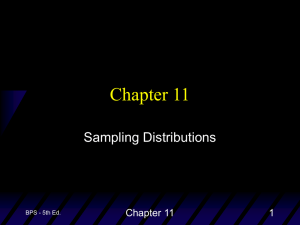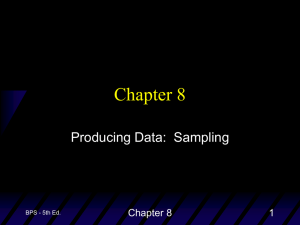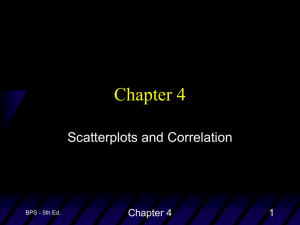Sampling Distribution
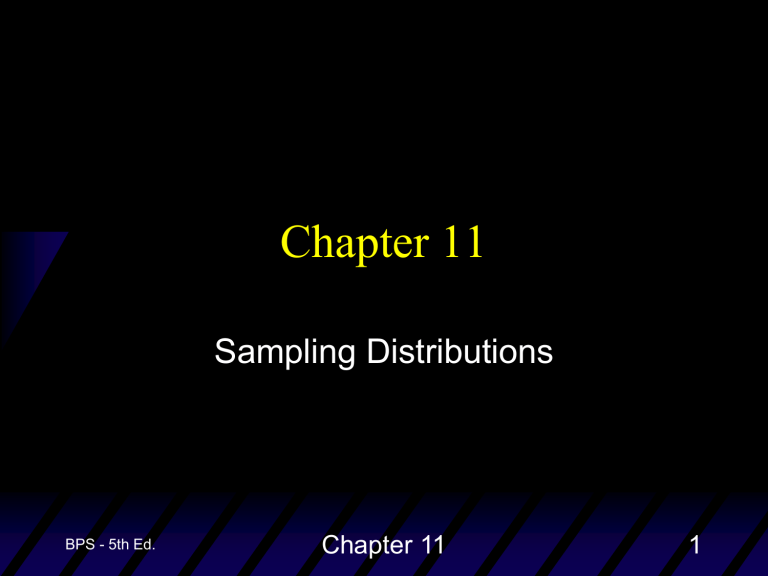
Chapter 11
Sampling Distributions
BPS - 5th Ed.
Chapter 11 1
Sampling Terminology
Parameter
– fixed, unknown number that describes the population
Statistic
– known value calculated from a sample
– a statistic is often used to estimate a parameter
Variability
– different samples from the same population may yield different values of the sample statistic
Sampling Distribution
– tells what values a statistic takes and how often it takes those values in repeated sampling
BPS - 5th Ed.
Chapter 11 2
Parameter vs. Statistic
A properly chosen sample of 1600 people across the United States was asked if they regularly watch a certain television program, and 24% said yes . The parameter of interest here is the true proportion of all people in the U.S. who watch the program, while the statistic is the value 24% obtained from the sample of 1600 people.
BPS - 5th Ed.
Chapter 11 3
Parameter vs. Statistic
The mean of a population is denoted by µ – this is a parameter .
The mean of a sample is denoted by – this is a statistic . is used to estimate µ .
The true proportion of a population with a certain trait is denoted by p – this is a
The proportion of a sample with a certain trait is denoted by (“ p-hat ”) – this is a statistic
ˆ used to estimate p .
BPS - 5th Ed.
Chapter 11 4
The Law of Large Numbers
Consider sampling at random from a population with true mean µ . As the number of (independent) observations sampled increases, the mean of the sample gets closer and closer to the true mean of the population.
( gets closer to µ )
BPS - 5th Ed.
Chapter 11 5
The Law of Large Numbers
Gambling
The “house” in a gambling operation is not gambling at all
– the games are defined so that the gambler has a negative expected gain per play (the true mean gain after all possible plays is negative)
– each play is independent of previous plays, so the law of large numbers guarantees that the average winnings of a large number of customers will be close the the (negative) true average
BPS - 5th Ed.
Chapter 11 6
Sampling Distribution
The sampling distribution of a statistic is the distribution of values taken by the statistic in all possible samples of the same size ( n ) from the same population
– to describe a distribution we need to specify the shape, center, and spread
– we will discuss the distribution of the sample mean (x-bar) in this chapter
BPS - 5th Ed.
Chapter 11 7
Case Study
Does This Wine Smell Bad?
Dimethyl sulfide (DMS) is sometimes present in wine, causing “off-odors”. Winemakers want to know the odor threshold – the lowest concentration of DMS that the human nose can detect. Different people have different thresholds, and of interest is the mean threshold in the population of all adults.
BPS - 5th Ed.
Chapter 11 8
Case Study
Does This Wine Smell Bad?
Suppose the mean threshold of all adults is
=25 micrograms of DMS per liter of wine, with a standard deviation of
=7 micrograms per liter and the threshold values follow a bell-shaped
(normal) curve.
BPS - 5th Ed.
Chapter 11 9
Where should 95% of all individual threshold values fall?
mean plus or minus two standard deviations
25
2(7) = 11
25 + 2(7) = 39
95% should fall between 11 & 39
What about the mean (average) of a sample of n adults? What values would be expected?
BPS - 5th Ed.
Chapter 11 10
Sampling Distribution
What about the mean (average) of a sample of n adults? What values would be expected?
Answer this by thinking: “What would happen if we took many samples of n subjects from this population?” (let’s say that n=10 subjects make up a sample)
– take a large number of samples of n =10 subjects from the population
– calculate the sample mean (x-bar) for each sample
– make a histogram (or stemplot) of the values of x-bar
– examine the graphical display for shape, center, spread
BPS - 5th Ed.
Chapter 11 11
Case Study
Does This Wine Smell Bad?
Mean threshold of all adults is
=25 micrograms per liter, with a standard deviation of
=7 micrograms per liter and the threshold values follow a bell-shaped (normal) curve.
Many (1000) repetitions of sampling n =10 adults from the population were simulated and the resulting histogram of the 1000 x-bar values is on the next slide.
BPS - 5th Ed.
Chapter 11 12
Case Study
Does This Wine Smell Bad?
BPS - 5th Ed.
Chapter 11 13
Mean and Standard Deviation of
Sample Means
If numerous samples of size n are taken from a population with mean
and standard deviation
, then the mean of the sampling distribution of is
(the population mean) and the standard deviation is:
(
is the population s.d.)
BPS - 5th Ed.
Chapter 11 14
Mean and Standard Deviation of
Sample Means
Since the mean of is
, we say that is an unbiased estimator of
Individual observations have standard deviation
, but sample means from samples of size n have standard deviation
. Averages are less variable than individual observations .
BPS - 5th Ed.
Chapter 11 15
Sampling Distribution of
Sample Means
If individual observations have the N( µ ,
) distribution, then the sample mean of n independent observations has the N( µ,
/ n square root{n} ) distribution.
“If measurements in the population follow a
Normal distribution, then so does the sample mean.”
BPS - 5th Ed.
Chapter 11 16
Case Study
Does This Wine Smell Bad?
Mean threshold of all adults is
=25 with a standard deviation of
=7 , and the threshold values follow a bell-shaped
( normal ) curve.
(Population distribution)
BPS - 5th Ed.
Chapter 11 17
Exercise 11.26: To estimate the mean height
of studets on your campus, you will meaure an
SRS of students. From government data,we
Know that the standard deviation of the heights
Of young men is about 2.8 inches.
Suppose that (unknown to you) he mean height of
All male students is 70 inches.
a)IF you choose a student at random, what is the probability that he is between 69 and 71 inches b) You measure 25 students. What is the sampling
Distribution of their average height?
BPS - 5th Ed.
Chapter 11 18
c) What is the probability that the mean height of your sample is between 69 and 71 inches?
BPS - 5th Ed.
Chapter 11 19
Central Limit Theorem
If a random sample of size n is selected from
ANY population with mean
and standard deviation
, then when n is large the sampling distribution of the sample mean X is approximately Normal:
X is approximately N( µ,
/ )
“No matter what distribution the population values follow, the sample mean will follow a
Normal distribution if the sample size is large.”
BPS - 5th Ed.
Chapter 11 20
Central Limit Theorem:
Sample Size
How large must n be for the CLT to hold?
– depends on how far the population distribution is from Normal
the further from Normal, the larger the sample size needed
a sample size of 25 or 30 is typically large enough for any population distribution encountered in practice
recall: if the population is Normal, any sample size will work ( n ≥1)
BPS - 5th Ed.
Chapter 11 21
Central Limit Theorem:
Sample Size and Distribution of x-bar
n=1 n=2 n=10 n=25
BPS - 5th Ed.
Chapter 11 22
11.31: The number of accidents per week at a
Hazardous intersection varies with mean 2.2
And standard deviation 1.4. This distribution
Takes only integer values, so it is certainly not
Normal.
a)Let x-bar be the mean number of accidents
Per week at the intersection during the year (52
Weeks). What is the approx. distribution of x-bar
According to the central limit theorem?
b) What is the approximate probability that x-bar
Is less than 2?
c) What is the approx. prob.that there are fewer than 100 accidents at the inters. In a year?
BPS - 5th Ed.
Chapter 11 23
Statistical Process Control
Goal is to make a process stable over time and keep it stable unless there are planned changes
All processes have variation
Statistical description of stability over time: the pattern of variation remains stable
(does not say that there is no variation)
BPS - 5th Ed.
Chapter 11 24
Statistical Process Control
A variable described by the same distribution over time is said to be in control
To see if a process has been disturbed and to signal when the process is out of control , control charts are used to monitor the process
– distinguish natural variation in the process from additional variation that suggests a change
– most common application: industrial processes
BPS - 5th Ed.
Chapter 11 25
x Charts
There is a true mean
that describes the center or aim of the process
Monitor the process by plotting the means
(x-bars) of small samples taken from the process at regular intervals over time
Process-monitoring conditions :
– measure quantitative variable x that is Normal
– process has been operating in control for a long period
– know process mean and standard deviation
that describe distribution of x when process is in control
Chapter 11 26 BPS - 5th Ed.
x Control Charts
Plot the means (x-bars) of regular samples of size n against time
Draw a horizontal center line at
Draw horizontal control limits at
± 3
/
– almost all (99.7%) of the values of x-bar should be within the mean plus or minus 3 standard deviations
Any x-bar that does not fall between the control limits is evidence that the process is out of control
Chapter 11 27 BPS - 5th Ed.
Case Study
Making Computer Monitors
Need to control the tension in millivolts
(mV) on the mesh of fine wires behind the surface of the screen.
– Proper tension is 275 mV ( target mean
)
– When in control, the standard deviation of the tension readings is
=43 mV
BPS - 5th Ed.
Chapter 11 28
Case Study
Making Computer Monitors
Proper tension is 275 mV ( target mean
). When in control, the standard deviation of the tension readings is
=43 mV.
Take samples of n =4 screens and calculate the means of these samples
– the control limits of the x-bar control chart would be
BPS - 5th Ed.
Chapter 11 29
Making
Computer
Monitors
(data)
Case Study
BPS - 5th Ed.
Chapter 11 30
Case Study
Making
Computer
Monitors
( chart)
(in control)
BPS - 5th Ed.
Chapter 11 31
Case Study
Making Computer Monitors
(examples of out of control processes)
BPS - 5th Ed.
Chapter 11 32
Natural Tolerances
For x-bar charts, the control limits for the mean of the process are
± 3
/
– almost all (99.7%) of the values of x-bar should be within the mean plus or minus 3 standard deviations
When monitoring a process, the natural tolerances for individual products are
± 3
– almost all (99.7%) of the individual measurements should be within the mean plus or minus 3 standard deviations
BPS - 5th Ed.
Chapter 11 33
Exercise 11.34: Airline passengers average
190 pounds (including carry on luggage) with a standard deviation of 35 pounds. Weights are not Normally distributed but they are not very non-Normal.
A commuter plane carries 19 passengers.
What is the approximate probability that the total weight of the passengers exceeds 400 pounds?
BPS - 5th Ed.
Chapter 11 34
